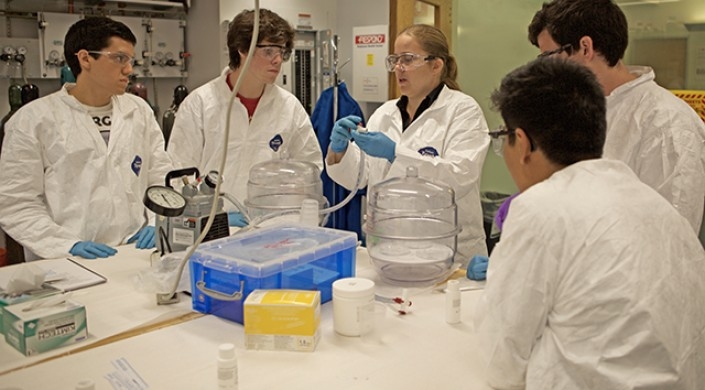News
Students from the Universidad Ingeniería y Technología (UTEC) in Peru work on a soil analysis device to help Peruvian farmers whose land has been contaminated due to illegal gold mining. (Photo by Molly Carlough/SEAS Communications)
Illegal gold mining, and its devastating environmental impacts, have spread rapidly across Peru, fueled by a series of financial collapses that rocked the country in the 20th century and a 360-percent increase in the price of gold.
Eight students from the Harvard John A. Paulson School of Engineering and Applied Sciences (SEAS) and the Universidad Ingeniería y Technología (UTEC) in Peru worked together to tackle the dire environmental crisis caused by illegal mining in Madre de Dios, a region in the southeastern corner of the country bordering Brazil and Bolivia.
Illegal gold mining has resulted in the devastation of thousands of hectares of the Amazon Basin and has exposed the surrounding populations to almost 40 tons of mercury dumped from these mining sites every year, according to the Amazon Conservation Association. A study conducted by the Carnegie Institute for Science found that 78 percent of residents of Puerto Maldonao, the region’s capital, have dangerously high levels of mercury in their bodies.
In addition to the public health consequences, this environmental crisis directly affects agriculture, one of the most significant contributors to the Peruvian economy. While the Peruvian government is attempting to stop illegal mining, an immediate focus is on reducing toxicity in soil used for agriculture. Now in its fifth year, the Harvard-UTEC Collaborative Program seeks to tackle this issue.
Students traveled to Madre de Dios to learn about the environmental crisis first-hand, visiting two agricultural communities -- Cuzco and Puerto Maldonando. Working with the farmers to understand their specific needs, the students were challenged to think of a tailored solution for soil analysis that would take into account the severe resource limitations of the region.
“We have been working with these communities in the highlands [Cuzco] and in the jungles [Puerto Maldonando], both of which have different levels of understanding of the soil, but in general they have no way of analyzing it,” explained Guillermo Ghiglino Vásquez de Velazco, a chemical engineering concentrator from UTEC. “They have this sort of qualitative idea when the soil is good and when it’s bad, but they always have to send their samples back to Lima which takes a while and is also quite expensive.”
After gathering information and analyzing the most important aspects from their work with farmers in Peru, the students concluded the seven-week program in Cambridge at the Harvard Active Learning Labs, where they collaborated to produce a working prototype of a soil analysis device, while considering the different challenges of its implementation in the field. The students studied the use of microfluidics to improve the design of the prototype developed by last year’s group.
The students used microfluidics to enhance soil analysis prototypes developed during the previous years. (Photo by Molly Carlough/SEAS Communications)
One of the biggest challenges for Claudia Gutierrez Collave, a mechanical engineering concentrator from UTEC, was the first step of determining what they wanted the prototype to do and what they needed to do to make that happen.
“I think that these two weeks were very intense and extensive,” she said. “We had one week of learning everything about microfluidics and the process of how we can do that in different ways. I think that the most difficult part was that first process of taking what we had learned and imagining what we needed to do for the project.”
A primary focus in prototyping the device was waste, as various chemicals are used to test each soil sample for different compounds. Working on a microscale ensured a minimal use of chemicals, thus making the amount of waste more manageable for farmers.
“The idea with these microfluidic devices is that we can make a lot more samples using the same amount of reagents, waste less of them and be able to help more people at the same time,” explained Ghiglino Vásquez de Velazco.
Using methods such as laser cutting and 3D printing, the students were able to create and test more than 20 prototypes, presenting their most successful version to SEAS faculty members at the culmination of the program. In addition to engineering a working prototype, the students also developed educational workshops to give farmers a deeper understanding of the soil they use.
The UTEC-SEAS collaborative summer program brings students from both institutions together to tackle the dire environmental crisis caused by illegal mining in Madre de Dios, a region in the southeastern corner of the country bordering Brazil and Bolivia. (Photo by Molly Carlough/SEAS Communications)
Topics: Environment
Cutting-edge science delivered direct to your inbox.
Join the Harvard SEAS mailing list.
Press Contact
Adam Zewe | 617-496-5878 | azewe@seas.harvard.edu



